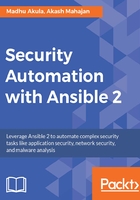
Summary
We have codified a fairly decent real-world stack for development using a combination of Ansible's features. By thinking about what goes in a LAMP stack overview, we can start by creating the roles. Once we have that thrashed out, the inpidual tasks are mapped to modules in Ansible. Any task that requires copying of a pre-defined configuration, but with dynamically-generated output, can be done by using variables in our templates and the constructs offered by Jinja2.
We will use the same approach to various security-related setups that could do with a bit of automation for orchestration, operations, and so on. Once we have a handle on how to do this for a virtual machine running our laptop, it can be repurposed for deploying on your favorite cloud-computing instance as well. The output is human readable and in text, so that it can be added to version control, various roles can be reused as well.
Now that we have a fairly decent idea of the terms we will be using throughout this book, let's get set for one final piece of the puzzle. In the next chapter, we will learn and understand how we can use automation and scheduling tools, such as Ansible Tower, Jenkins, and Rundeck, to manage and execute playbooks based on certain event triggers or time durations.